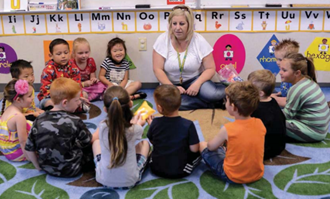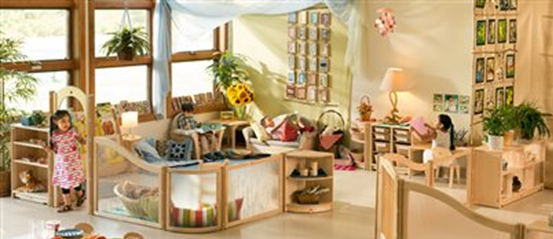8.3: Environmental Factors in Supporting Language and Literacy

How the learning environment is arranged affects how children learn to talk, read, and write. An environment that fosters language development, two-way communication, and literacy skills provides rich curriculum content. The daily schedule accommodates a variety of groupings (e.g., large group, small group, and individual), and the learning materials fascinate children. Children learn more when adults model language and literacy as well as provide playful, purposeful instruction. Play spaces with literacy props (e.g., signs, lists) allow children to congregate and to make choices that foster rich language and literacy experiences.
- Create time in the daily routine for adult-child and child-child interactions.
- Have space and times for large-group times
- Create spaces and times for children to gather in small groups
- Provide a space to display family-related items; consider how to add text to those displays
- Organize your classroom into centers or interest areas to create clear spaces for children to engage and collaborate (and communicate), including
- A dramatic play area
- A block area
- An art area
- A writing area
- A cozy library or book area
- A science area
- A game area
- A math area
- Choose materials for small- and large-group times that the children will be interested in and use them with intention
- Create a learning environment to fascinate children and prompt conversations
- Extend the classroom beyond its wall; being outdoors, going on walks, and taking field trips are all great for promoting conversation
- Be flexible in your environment; allow children to expand their ideas to new areas[1]

Pause to Reflect
How might the centers just listed each support language and literacy?
Learning English as a Second Language
In California as many as half of children will be identified as English learners upon kindergarten entry. The home languages of these children include Spanish, Vietnamese, Cantonese, Hmong, Tagalog, Korean, and other languages.
In general the development of a second language follows these predictable stages
| Stage | Description of Stage of Second Language Development |
| 1st stage | The child uses their home language to try and communicate |
| 2nd stage | The child figures out that it is not successful to use the home language so they pass through a period of observation and listening |
| 3rd stage | The child attempts to use new language in more abbreviated form through the use of one or two word sentences |
| 4th stage | The child begins to use more elaborated phrases and short sentences to communicate in the new language |
While some express concern that learning more than one language is confusing or delays children’s development, there have been no negative effects of bilingualism found in research. According to Gigi Luk, an associate professor at Harvard’s Graduate School of Education, “bilingualism is an experience that shapes our brain for a lifetime.” There are many potential benefits to knowing more than one language, including: increased ability to pay attention, better reading of social cues, better reading ability, better school performance and engagement, increased comfort with diversity and different cultures, and even protection from age-related dementia[2] It’s important for educators to support and advocate for the maintenance of children’s home languages for both the benefits mentioned here but also because,[3] “[t]he child’s first language is critical to his or her identity. Maintaining this language helps the child value his or her culture and heritage, which contributes to a positive self-concept.[4]
Children who are English learners bring a wealth of ability and knowledge as well as varied cultural backgrounds to early childhood settings; English learners also require curricular adaptations to make the most of their abilities while they progress toward full English proficiency. The high-quality early childhood practices described in the other domains will also benefit preschool children who are English learners, but they may not be enough.[5]
There are many resources available to support teachers of children who are English Language Learners including these from the California Department of Education:
The California Preschool Learning Foundations (Volume 1)
The California Preschool Curriculum Framework (Volume 1)
Preschool English Learners (2nd edition)
- The California Preschool Curriculum Framework, Volume 1 by the California Department of Education is used with permission ↵
- Kamenetz, A. (2016). 6 Potential Brain Benefits Of Bilingual Education. Retrieved from https://www.npr.org/sections/ed/2016/11/29/497943749/6-potential-brain-benefits-of-bilingual-education. ↵
- Content by Jennifer Paris is licensed by CC-BY-4.0 ↵
- IDRA. (2000). Why is it Important to Maintain the Native Language? Retrieved from https://www.idra.org/resource-center/why-is-it-important-to-maintain-the-native-language/ ↵
- The California Preschool Curriculum Framework, Volume 1 by the California Department of Education is used with permission ↵

